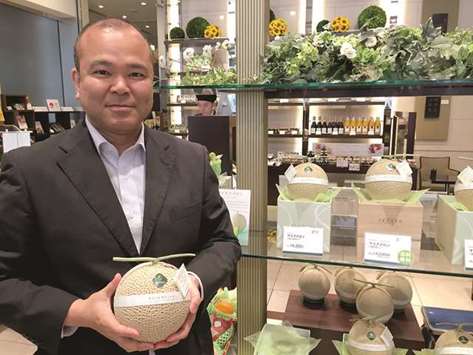Naoto Hiraishi regards his melon with an earnest expression, turning it carefully in his hands as if it were a diamond and examining at it from every angle.
“Look at that, the pattern on the surface is perfectly even,” says the manager of the Senbikiya fruit shop with a beaming smile.
In some respects the round fruit is indeed a jewel, though the layman might only recognise that when he sees the price tag – 27,000 yen or around 250 dollars.
“We sell the best melons in Japan,” says Hiraishi. “In other words, the best melons in the world.”
Fruit is a luxury industry in Japan, and it’s very lucrative. That’s not to say that fruit is a rarity in the world’s third largest economy. The fruit Hiraishi sells is grown in Japan, it’s not imported.
At any good supermarket you can buy melons as well as strawberries, cherries, peaches, grapes and all sorts of other fruits – though the prices are perhaps a little higher than what people in the West are used to.
But what Hiraishi and other similar fruit shop owners supply is in a class of its own.
What makes it possible is Japan’s culture of gift-giving. “Eighty per cent of our customers buy fruit as a gift,” says Hiraishi.
The Japanese love food in general and particularly fruit, meaning that they will often give it to business partners, friends and relations as a sign of their appreciation.
Japanese food producers therefore take a lot of care with their products, as well as its packaging.
Take the example of a melon. “A melon plant normally bears about six fruit,” says Hiraishi. “But with our melons the farmer cuts half off.” After a time he cuts off another two and the one that’s left is the one that grows “best.”
That fruit gets all the plant’s nutrients to itself for around 100 days. But what does “best” mean is this scenario?
If the melon is just a tiny bit “lopsided” or “bumpy” it’s value immediately drops.
“The fruit has to have an even pattern, be nice and heavy and have a lovely round shape,” says Hiraishi.
There are other farmers who specialise in luxury strawberries.
Strawberries from Ichigo Co in the province of Niigata cost 1,000 yen (9 dollars) each. They are grown under LED lights in a special high-tech, one-of-a-kind lab, in which the temperature, humidity and oxygen levels are all controlled.
That means the harvest is not weather-dependent and is unaffected by pests, meaning the farmer doesn’t have to use chemicals.
You can buy Ichigo’s hand-picked strawberries online in sets of six, and they arrive beautifully packed in a box not unlike those used for expensive chocolates.
Senbikiya, which was founded 183 years ago, also sells its fruit in elaborate boxes and cartons.
Back then, when the shop was first set up, the produce it sold was nothing special, says Hiraishi. It was the wife of the second owner, the daughter of a trader in katsuobushi (dried and fermented tuna) who began selling fruit as a luxury product.
The shop’s main outlet can be found at one of Tokyo’s best addresses, surrounded by big banks.
More than half of their customers are business clients, Hiraishi says, as he lays his melon carefully back on the shelf.
Just a few days earlier, at the first auction for this year’s harvest in Hokkaido, the northernmost of Japan’s islands, a pair of Yubari melons sold for 1.5 million yen (13,700 dollars).
The trader who purchased them announced that he would donate them to a primary school.
Although he didn’t get a taste himself, it was still a clever public relations investment. After all, Japan’s media dedicates huge coverage to stories about fruit. – DPA

In the Senbikiya fruit shop in Tokyo, run by Naoto Hiraishi, one melon is sold for 27,000 Yen, or around 350 dollars. Luxury fruit is a lucrative and prestigious business.


